CHEVROLET S10 1993 2.G Owners Manual
Manufacturer: CHEVROLET, Model Year: 1993, Model line: S10, Model: CHEVROLET S10 1993 2.GPages: 356, PDF Size: 20.85 MB
Page 221 of 356
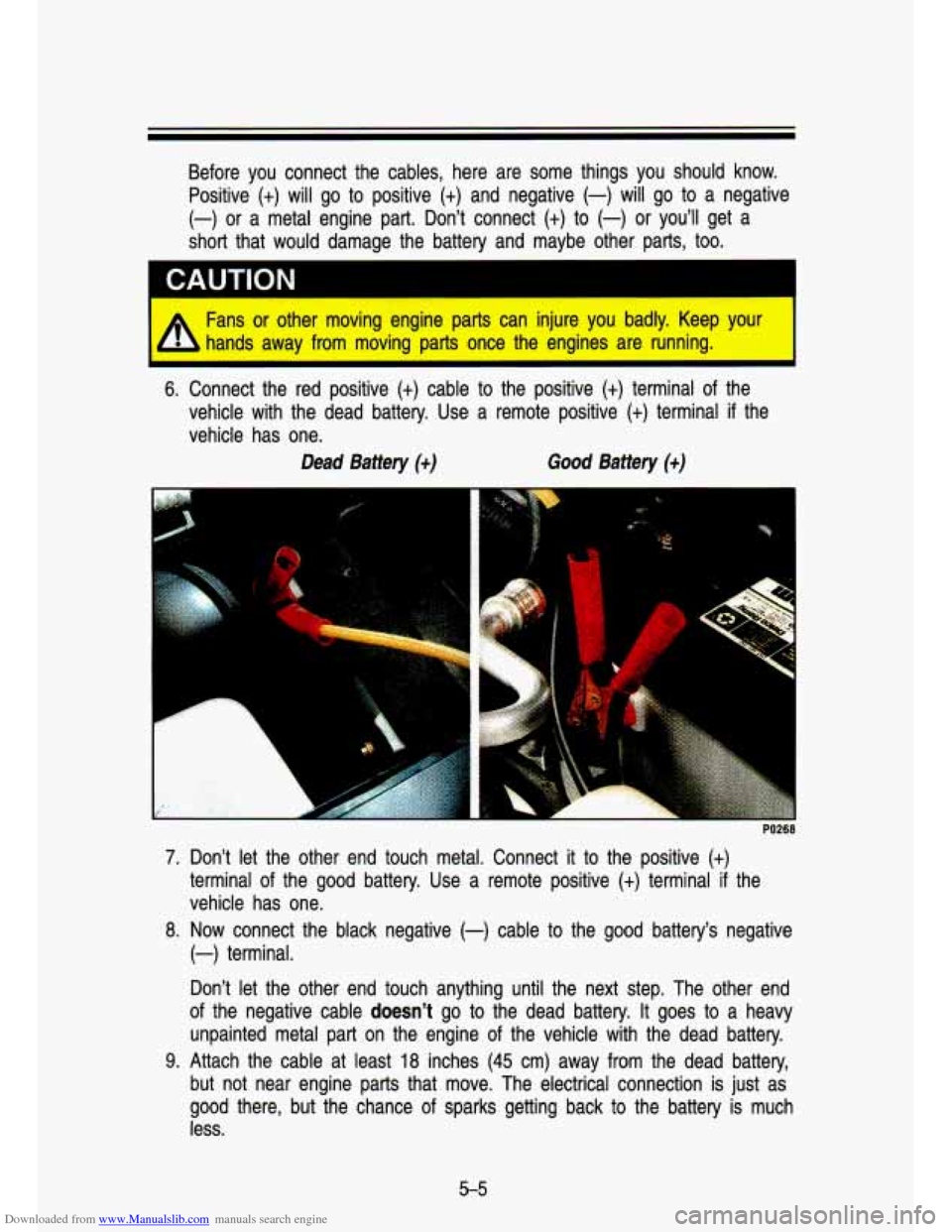
Downloaded from www.Manualslib.com manuals search engine CAUTION
Before you connect the cables, here are some things you should\
know. Positive
(t) will go to positive (t) and negative, (-) will go to a negative
(-) or a metal engine part. Don't connect (t) to (-) or you'll get a
short that would damage the battery and maybe other parts, too\
.
/ Fans or other moving engine parts can injure you badly. Keep \
your
hands away from moving parts once the engines are running.
6. Connect the red positive (t) cable to the positive (t) terminal of the
Y
vehicle with the dead battery. Use a remote positive (t) terminal if the
vehicle has one.
Dead Battery (+) Good Battery (t)
7.
8.
9.
Don't let the other end touch metal. Connect it to the positi\
ve (t)
terminal of the good battery. Use a remote positive (t) terminal if the
vehicle has one.
Now connect the black negative
(-) cable to the good battery's negative
(-) terminal.
Don't let the other end touch anything until the next step. T\
he other end
of the negative cable doesn't go to the dead battery. It goes to a heavy
unpainted metal part on the engine of the vehicle with the dead battery.
Attach the cable at least
18 inches (45 cm) away from the dead battery,
but not near engine parts that move. The electrical connection \
is just as good there, but the chance of sparks getting back to the battery is much
less.
5-5
Page 222 of 356
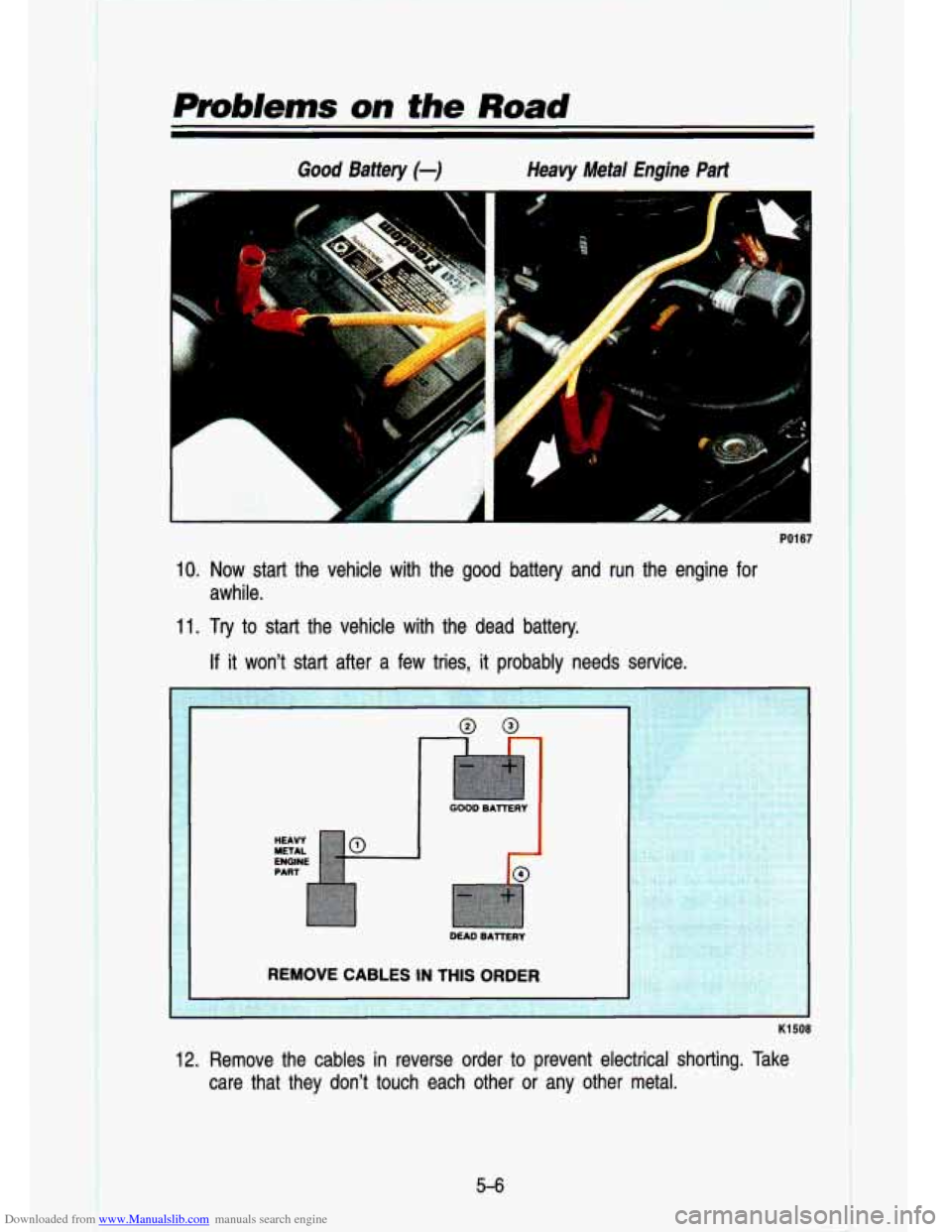
Downloaded from www.Manualslib.com manuals search engine Prob/ems on the Road
Good Battery (-) Heavy Metal Engine Part
r“ 1 -L
L
PO1 67
10. Now start the vehicle with the good battery and run the engine fo\
r
awhile.
11. Try to start the vehicle with the dead battery.
If it won’t start after a few tries, it probably needs service.
12. Remove the cables in reverse order to prevent electrical shorting. Take
care that they don’t touch each other or any other metal.
5-6
I !
Page 223 of 356
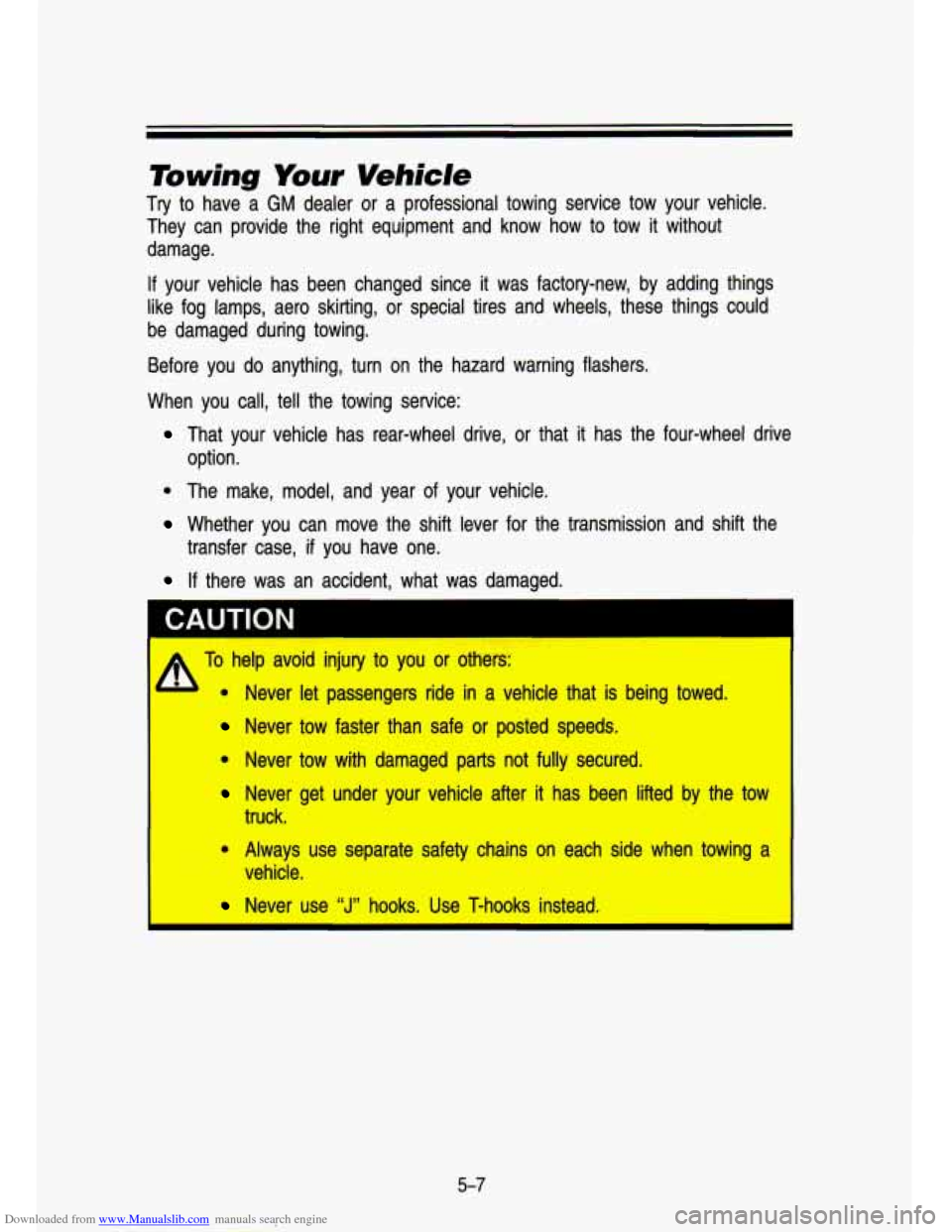
Downloaded from www.Manualslib.com manuals search engine Towing Your Vehicle
Try to have a GM dealer or a professional towing service tow your vehicle.
They can provide the right equipment and know how to tow it without
damage.
If your vehicle has been changed since it was factory-new, by adding things
like fog lamps, aero skirting, or special tires and wheels, th\
ese things could
be damaged during towing.
Before you do anything, turn on the hazard warning flashers.
When you call, tell the towing service:
That your vehicle has rear-wheel drive, or that it has the fo\
ur-wheel drive
0 The make, model, and year of your vehicle.
Whether you can move the shift lever for the transmission and \
shift the
If there was an accident, what was damaged.
option.
transfer case,
if you have one.
I CAUTION
To help avoid injury to you or others:
A * Never let passengers ride ‘in a vehicle that is being towed.
Never tow faster than safe or posted speeds.
0 Never tow with damaged pads not fully secured.
Never get under your vehide after it has been lifted by the tow
. 0 Always use separate safety chains on each side when towing a
truck.
vehicle.
Never use “J” hooks. Use T-hooks instead.
5-7
Page 224 of 356
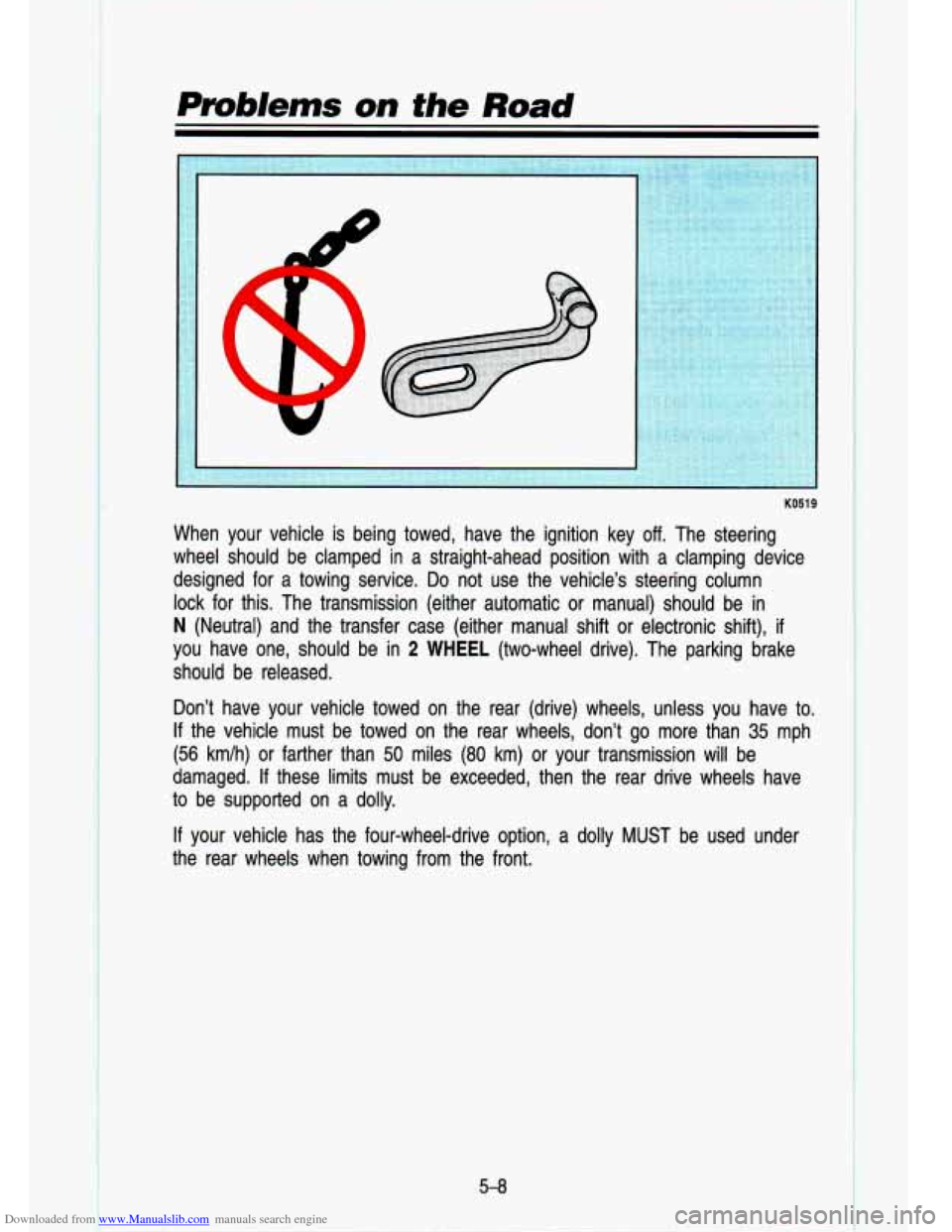
Downloaded from www.Manualslib.com manuals search engine , vr
KO51 9
When your vehicle is being towed, have the ignition key off. The steering
wheel should be clamped in a straight-ahead position with a clamping device
designed for a towing service. Do not use the vehicle's steeri\
ng column
lock for this. The transmission (either automatic or manual) should\
be in
N (Neutral) and the transfer case (either manual shift or elec\
tronic shift), if
you have one, should be in 2 WHEEL (two-wheel drive). The parking brake
should be released.
Don't have your vehicle towed on the rear (drive) wheels, un\
less you have
to,
If the vehicle must be towed on the rear wheels, don't go more than 35 mph
(56 km/h) or farther than 50 miles (80 km) or your transmission will be
damaged.
If these limits must be exceeded, then the rear drive wheels have\
to be supported on a dolly.
If your vehicle has the four-wheel-drive option, a dolly
MUST be used under
the rear wheels when towing from the front.
5-8
Page 225 of 356
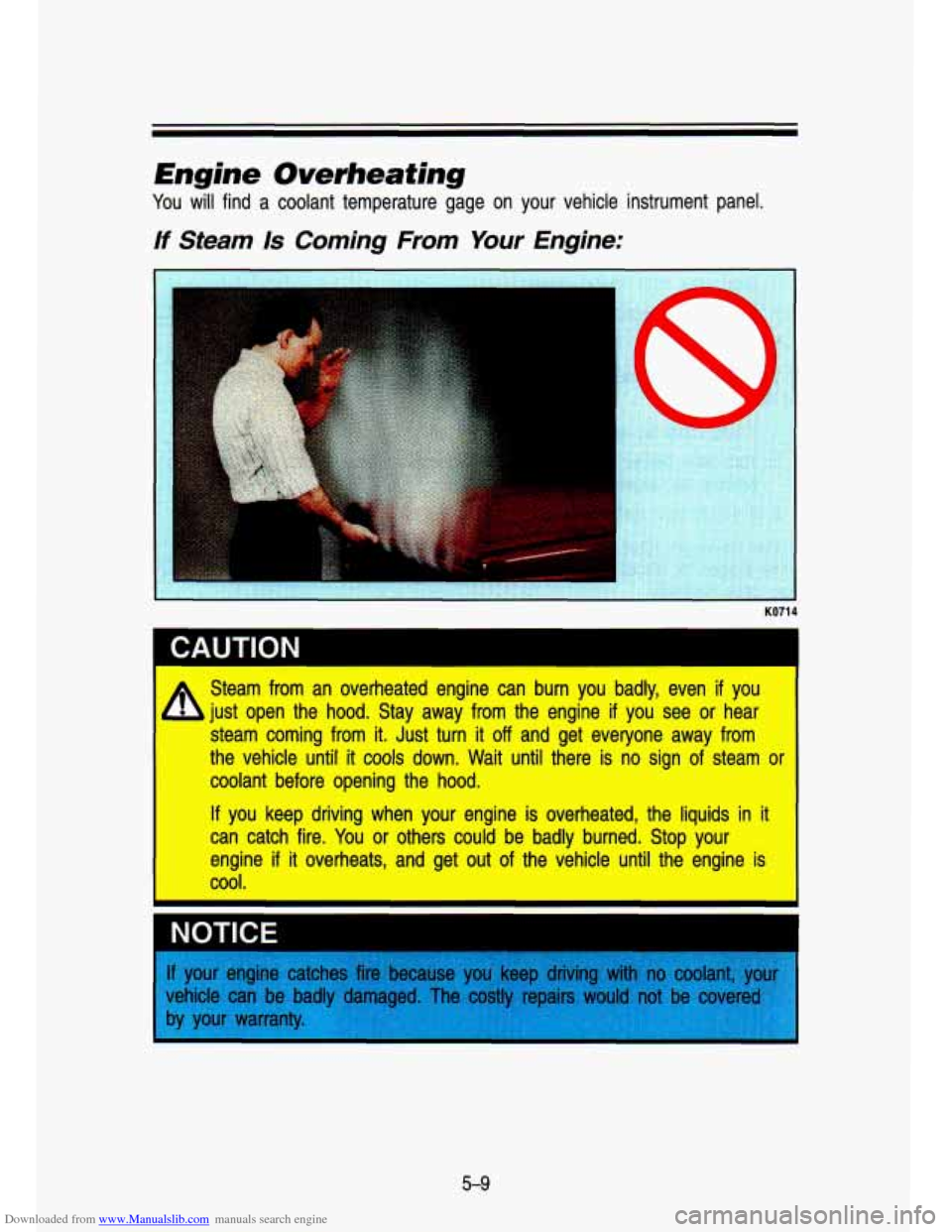
Downloaded from www.Manualslib.com manuals search engine Engine Overheating
You will find a coolant temperature gage on your vehicle inslrument panel.
If Steam IS Coming From Your Engine:
. ,, ..;., .. ,., - , . I ~ &<4g&&$': $&$&&%,+ I , $.$ .?,'$;;$ ;,";,&,.,.&
..
KO71 4
1 ,A Steam from an overheated engine can burn you badly, even if you
just open the hood. Stay away from the engine
if you see or hear
steam coming from it. Just turn it
off and get everyone away from
the vehicle until it cools down. Wait until there is no sign of steam or
coolant before opening the hood.
If you keep driving when your engine is overheated, the liquids in it
can catch fire. You or others could be badly burned. Stop your
engine
if it overheats, and get out of the vehicle until the engine is
I cool.
NCITICE
5-9
Page 226 of 356
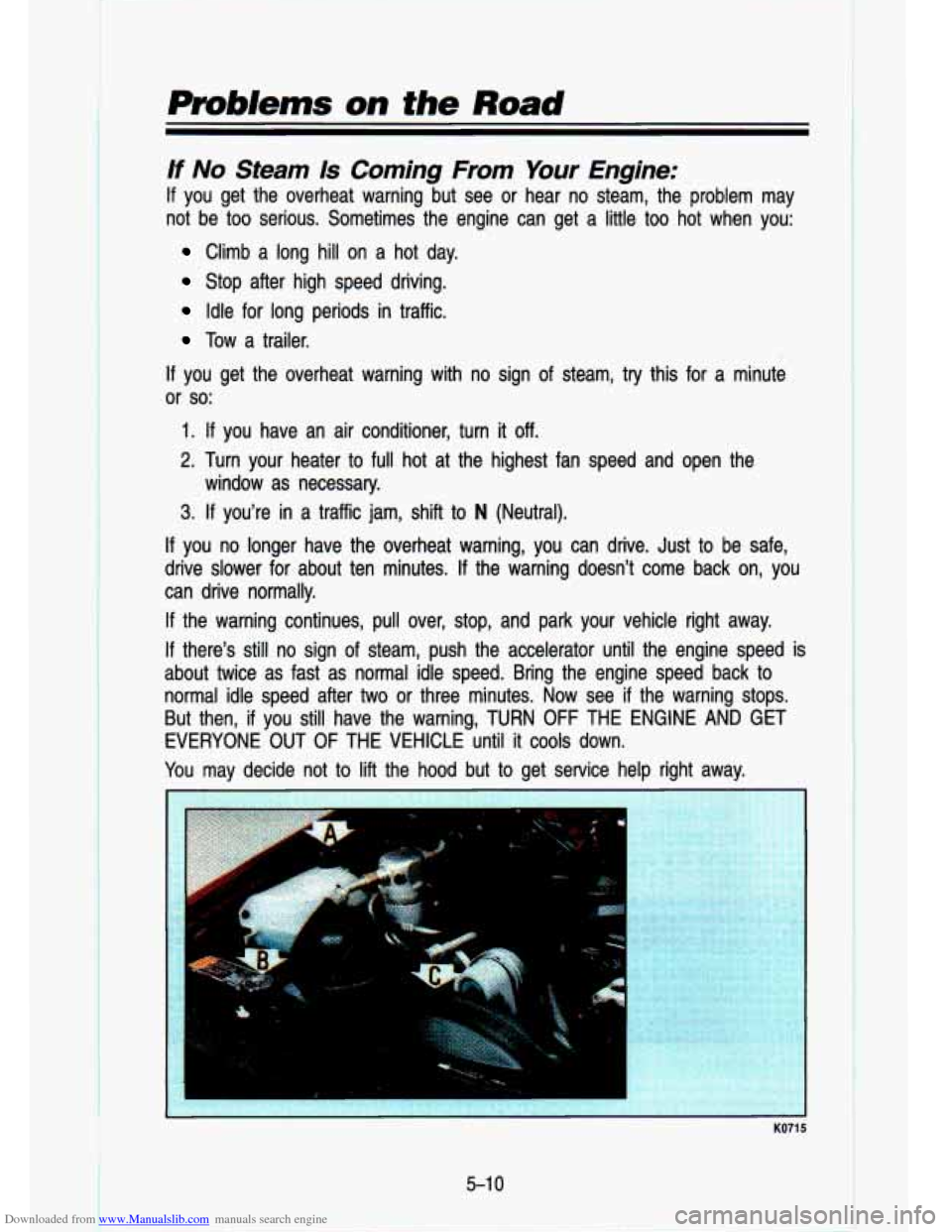
Downloaded from www.Manualslib.com manuals search engine Problems on the Road
If No Steam Is Coming From Your Engine:
If you get the overheat warning but see or hear no steam, the problem may
not be too serious. Sometimes the engine can get a little
too hot when you:
Climb a long hill on a hot day.
Stop after high speed driving.
Idle for long periods in traffic.
Tow a trailer.
If you get the overheat warning with no sign of steam, try this for a minute
or so:
1. If you have an air conditioner, turn it off.
2. Turn your heater to full hot at the highest fan speed and open the
3. If you're in a traffic jam, shift to N (Neutral).
window as necessary.
If you no longer have the overheat warning, you can drive. Just to
be safe,
drive slower for about ten minutes. If the warning doesn't com\
e back on, you
can drive normally.
If the warning continues, pull over, stop, and park your vehicle \
right away.
If there's still no sign of steam, push the accelerator until the engine speed is
about twice as fast as normal idle speed. Bring the engine sp\
eed back to
normal idle speed after
two or three minutes. Now see if the warning stops.
But then,
if you still have the warning, TURN OFF THE ENGINE AND GET
EVERYONE
OUT OF THE VEHICLE until it cools down.
You may decide
not to lift the hood but to get service help right away.
KO71 5
5-1 0
I
Page 227 of 356
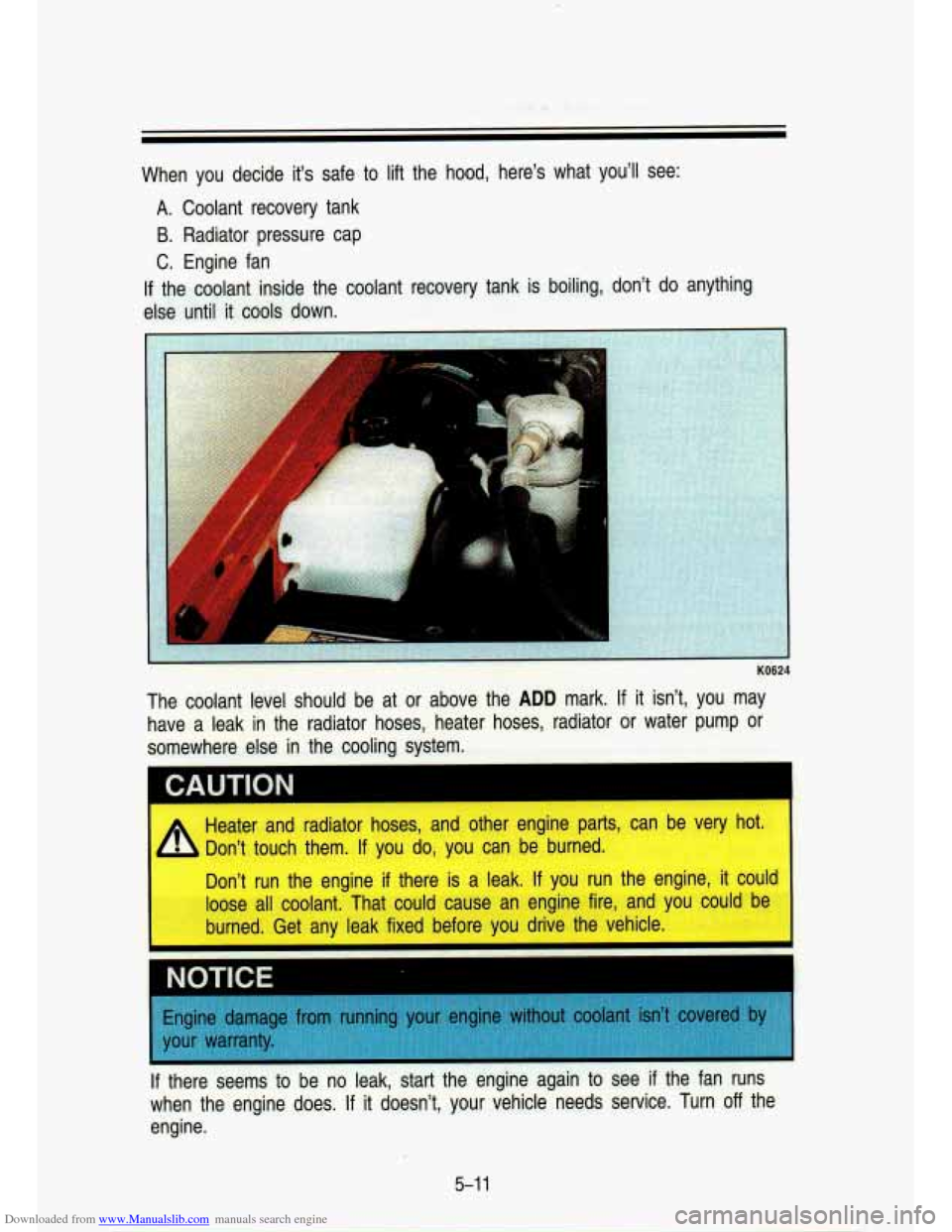
Downloaded from www.Manualslib.com manuals search engine When you decide it's safe to lift the hood, here's what you'll see:
A. Coolant recovery tank
B. Radiator pressure cap
C. Engine fan
If the coolant inside the coolant recovery tank is boiling, don't do anything
else until it cools down.
The coolant level should be at or above the
ADD mark. If it isn't, you may
have a leak in the radiator hoses, heater hoses, radiator or water pump or
somewhere else in the cooling system.
CAUTION I
Heater and radiator hoses, and other engine parts, can be very\
hot.
Don't touch them.
If you do, you can be burned.
loose all coolant. That could cause an engine fire, and you could be
burned. Get any leak fixed before you drive the vehicle. run the engine
if there is a leak. If you run the engine, it could
NOTICF
If there seems
to be no leak, start the engine again to see if the fan runs
when the engine does.
If it doesn't, your vehicle needs service. Turn off the
engine.
5-1 1
Page 228 of 356
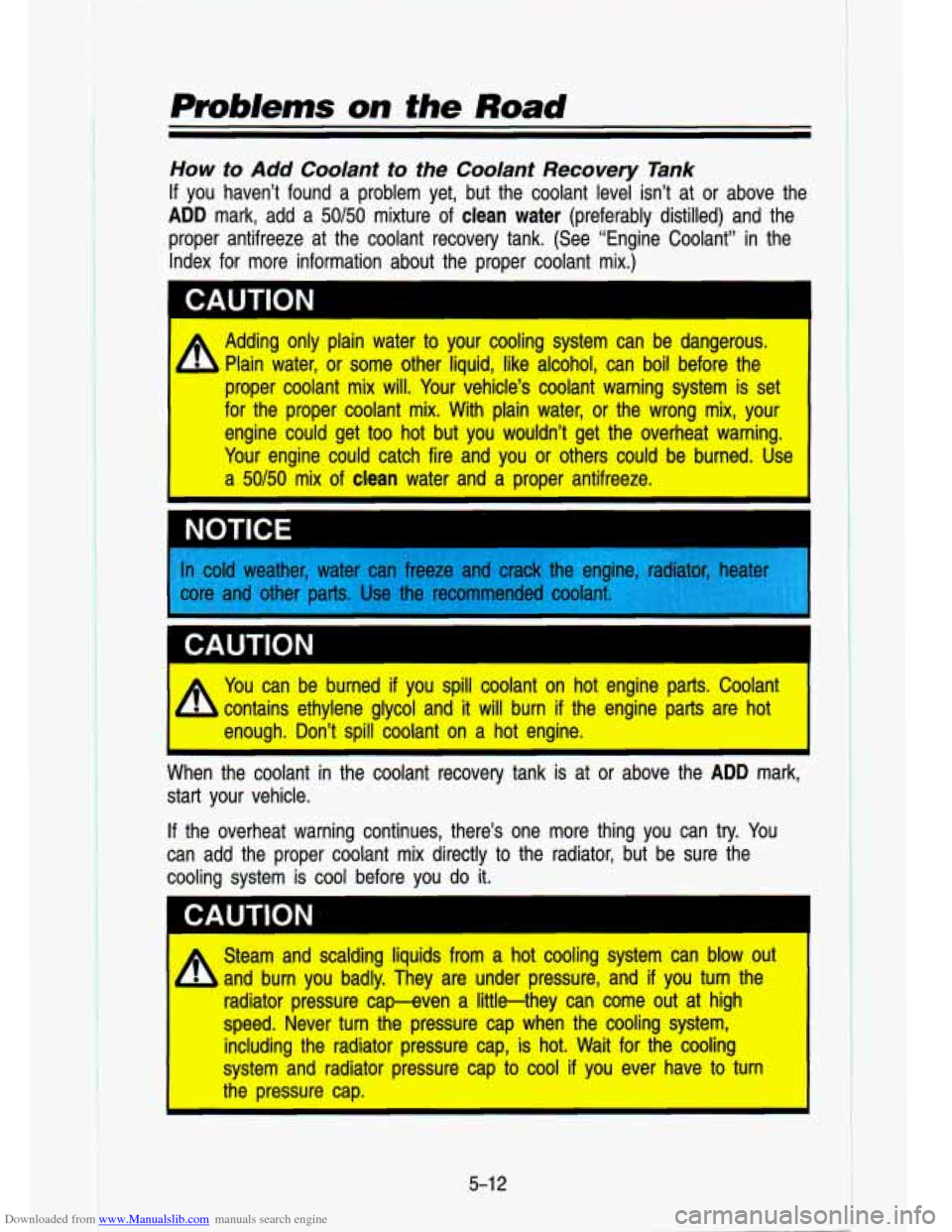
Downloaded from www.Manualslib.com manuals search engine How to Add Coolant to the Coolant Recovery Tank
If you haven’t found a problem yet, but the coolant level isn’t at or above the
ADD mark, add a 50/50 mixture of clean water (preferably distilled) and the
proper antifreeze at the coolant recovery tank. (See “Engine\
Coolant” in the Index for more information about the proper coolant mix.)
I CAUTION
4
Adding only plain water to your cooling system can be dangerous.
Rain water,
or some other liquid, like alcohill, can boil before the
proper coolant mix
will. Your vehicle’s coolant warning system is set
for the proper coolant mix. With plain water, or the wrong mix, your
engine could get
too hot but you wouldn’t get the overheat warning.
Your engine could catch fire and you or others could be burned. Use
‘a 5Q/M mix of clean wafer and a proper antifreeze.
NOTICE
In cold weather, water can freeze and crack the en1
core and other
parts. Use the recommended coolan
*
I CAUTION
I I
You can be burned if you spill coolant on hot engine parts. Coolant
b contains ethylene glycol and it wil’l burn if the engine parts are hot
I’ enough. Don’t spill coolant on a hot engine.
When the coolant in the coolant recovery tank is at or above \
the
ADD mark,
start your vehicle.
If the overheat warning continues, there’s one more thing you c\
an try. You
can add the proper coolant mix directly to the radiator, but \
be sure the
cooling system
is cool before you do it.
A
Steam and scalding liquids from a hot cooling system can blow out
and burn you badly. They are under pressure, and if you turn the
radiator pressure cap-even a little-they can come out at high
speed. Never turn the pressure cap when the cooling system, including the radiator pressure cap, is hot. Wait for the cooling
system and radiator pressure cap
to cool if you ever have to turn
the pressure cap.
5-1 2
Page 229 of 356
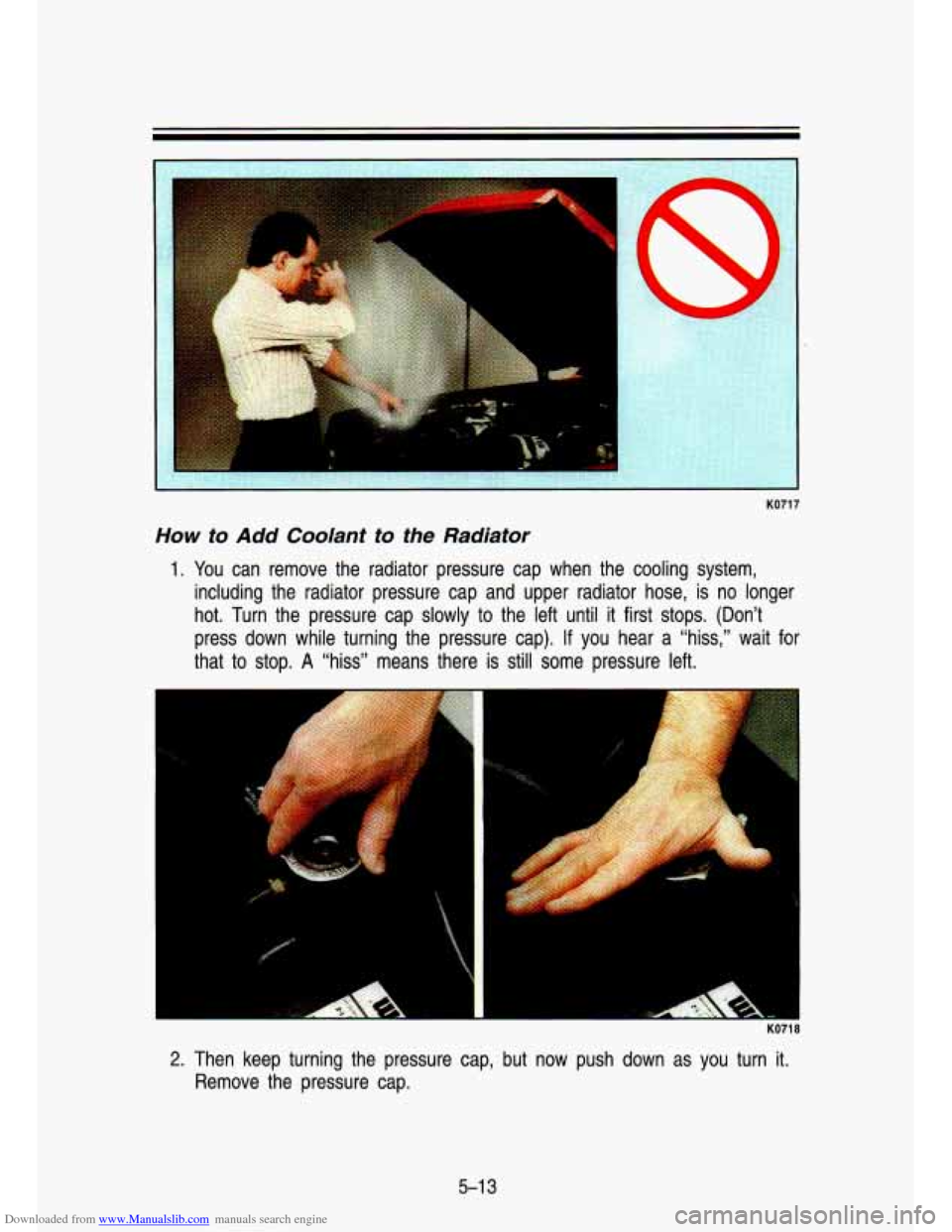
Downloaded from www.Manualslib.com manuals search engine KO71 7
How to Add Coolant to the Radiator
1. You can remove the radiator pressure cap when the cooling system,
including the radiator -pressure cap and upper radiator hose,
is no longer
hot. Turn the pressure cap slowly to the left until
it first stops. (Don’t
press down while turning the pressure cap).
If you hear a “hiss,” wait for
that to stop.
A “hiss’’ means there is still some pressure left.
I
KO7
2. Then keep turning the pressure cap, but now push down as you \
turn it.
Remove the pressure cap.
5-1 3
Page 230 of 356
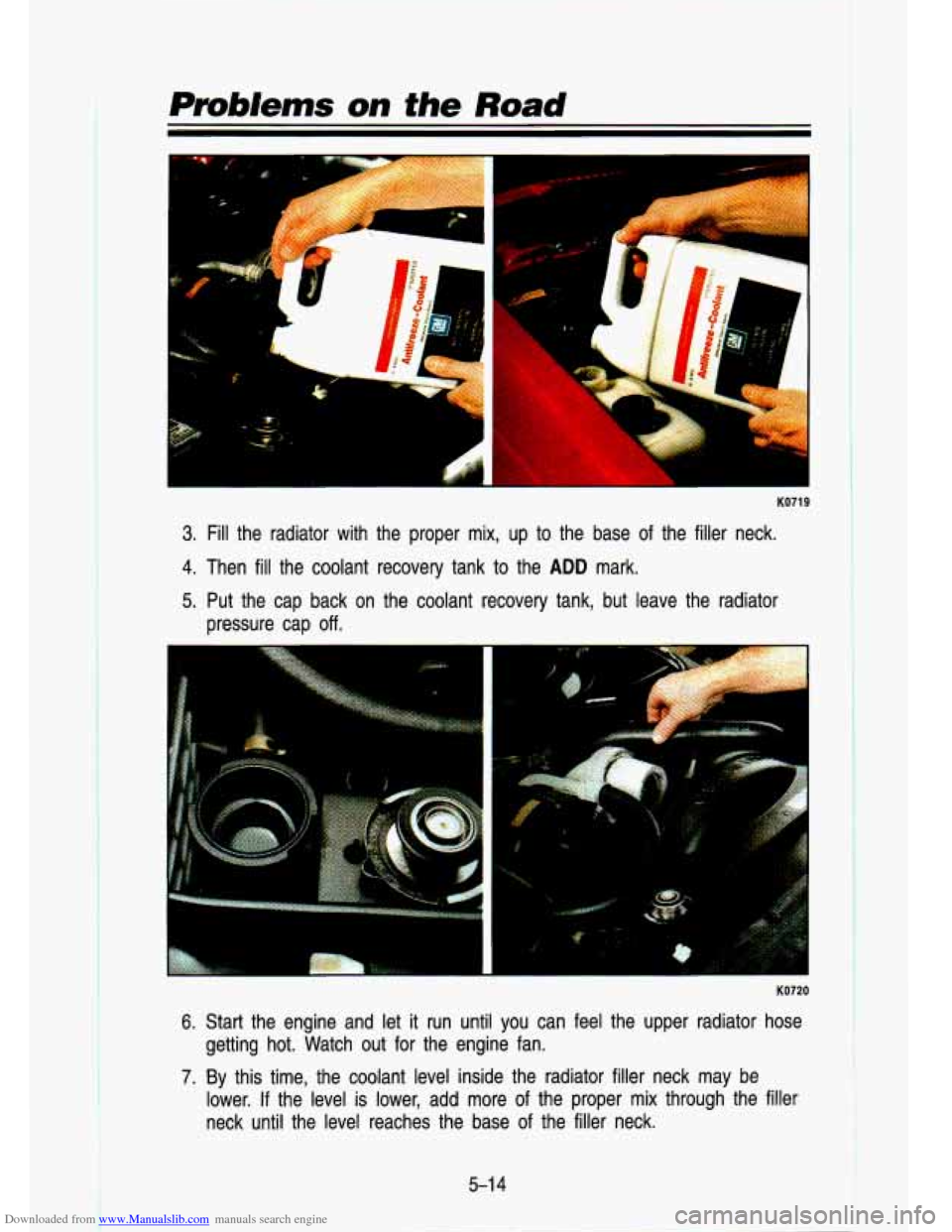
Downloaded from www.Manualslib.com manuals search engine Pmb/ems on the Road
c
KO719
3. Fill the radiator with the proper mix, up to the base of the filler neck.
4. Then fill the coolant recovery tank to the ADD mark.
5. Put the cap back on the coolant recovery tank, but leave the radi\
ator
pressure cap
off.
KO720
6. Start the engine and let it run until you can feel the upper radiator hose
7. By this time, the coolant level inside the radiator filler neck m\
ay be
getting hot. Watch out for the engine fan.
lower.
If the level is lower, add more of the proper mix through the filler
neck until the level reaches the base
of the filler neck.
5-1 4